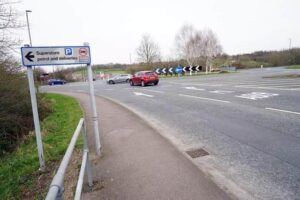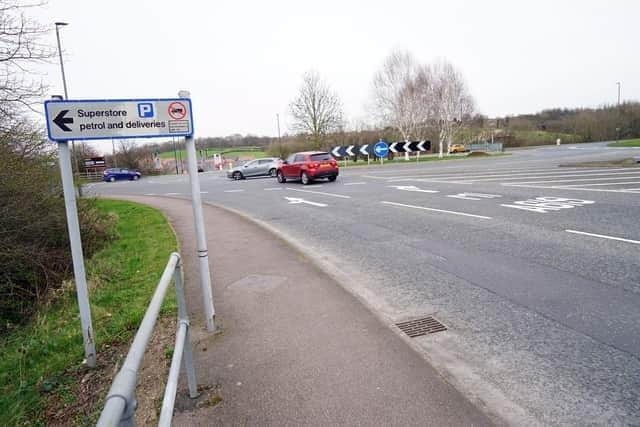
Regeneration plans for Derbyshire have moved a step closer including the long-awaited £166m Chesterfield-to-Staveley bypass scheme after the county council’s cabinet rubber-stamped the allocation of millions of pounds of funding from the East Midlands Combined County Authority along with a list of potential projects.
Derbyshire County Council’s Cabinet approved Government-backed EMCCA funding allocations for the area alongside a list of potential projects as part of the council’s Regeneration Project Pipeline at a meeting on October 16.
Deputy Leader Cllr Rob Reaney, who is also the Cabinet Member for Economic Development and Regeneration, said: “We’re committed to working with EMCCA to drive a higher quality of life through investing in the Derbyshire economy, backing our commitment to create more prosperous, green and sustainable places with opportunities for everyone.”
Projects supported by the funding include investigations of options for the Glapwell bypass, the Chesterfield to Staveley regeneration route and access to Willington along with work on the A61 corridor allowing further development at the Avenue, in Wingerworth, and a number of ‘active travel’ projects to encourage walking and cycling.
The Labour Government has not yet made any commitments to provide the remaining overall estimated, necessary funding to complete and get the Chesterfield-Staveley bypass scheme up-and-running but EMCCA has stressed that it will keep engaging with Government and partners to make sure any future funding decisions reflect the needs of the area.
But the county council still has the scheme in its sights and hopes to see a new single carriageway route of nearly four miles built between Chesterfield and Staveley relieving congestion on the existing network in the area and reducing traffic-related emissions and pollution associated with congestion and it is also hoped the scheme will provide economic growth, jobs and homes, and revive brownfield land.
The county council originally submitted an outline business case to the former Conservative Government after working closely with Chesterfield Borough Council seeking £141m to support delivery of the project alongside a necessary ‘local contribution’ of £25m to fund the overall scheme which would bring its total cost to £166m.
East Midlands Mayor Claire Ward has previously confirmed EMCCA has committed £2.5m from the 2025-26 City Regeneration Sustainable Transport Settlement to progress with the next stage of this scheme and she has recently said she is keen to invest money for a feasibility study pending a remaining business case and a ground investigation while awaiting a Government decision on the scheme to formally give it the go-ahead.
EMCCA stated that funding for this ground investigation is already planned for 2025-26 in its City Region Sustainable Transport budget separately from a recent Government funding announcement for transport projects and the authority added that it will keep working closely with partners and the Government to make sure any plans fit with the wider goals for the region.
Government pipeline funding via EMCCA currently includes the £2bn Transport for City Regions fund for 2026 to 2032, the £160m East Midlands Investment Zone monies for 2025 to 2035 and the £38m annual Investment Fund, all of which help provide EMCCA with the ability to build a strong pipeline of investment into which the county council’s own programme will feed.
Other potential schemes as part of the pipeline plans include a review of the design of M1 Junction 30 and Treble Bob between Barlborough and Clowne which may see increased traffic from the approved Clowne Garden Village housing scheme, and Cllr Reaney also highlighted that new proposals are being considered for the A61 / Avenue project.
The list of potential projects under the county council’s Regeneration Project Pipeline, which also features market town centre revamps, has been developed under programme areas including; Growth Zone North; Growth Zone South; Market Towns; Culture, Heritage and Tourism; And Enabling Infrastructure.
Growth Zone North includes the Staveley Growth Corridor, Spire Neighbourhood and the Station Masterplan in Chesterfield, and further proposals for the A61/Avenue.
Growth Zone South includes the South Derbyshire Growth Zone near Derby, New Stanton Park near Ilkeston, and the redevelopment of the former Willington Power Station for commercial purposes.
Market Towns include town centre redevelopments in Eckington, Killamarsh, Woodville, Clay Cross, Swadlincote, Shirebrook and Melbourne, revitalising Buxton, including the relocation of the library and museum, and the Matlock Market Hall redevelopment.
Culture, Heritage and Tourism includes expansion and integration of cycle and walking routes such as the White Peak Loop and Derwent Valley, Bolsover Loop and Bennerley, the Chesterfield Canal restoration and completion of missing sections, and comprehensive regeneration and redevelopment at key sites within Derwent Valley Mills World Heritage Site.
Enabling Infrastructure includes developing the implementation of a flood resilience work programme, reviewing the design of M1 Junction 30 and Treble Bob between Barlborough and Clowne which may see increased traffic from the approved Clowne Garden Village housing scheme, and the completion of the White Peak Loop for cycling.
The county council has also identified a number of potential projects aimed at addressing some of the key economic challenges around labour market shortages, skills shortages and the need to expand into new and different sectors to benefit the local economy.
These include: Skills and Employment including a Construction Skills Hub, Apprenticeship or early careers schemes and a Rail training hub; Sector Development and Sector Support including Visitor Economy, Minerals and quarrying, Construction and engineering, green tech and advanced manufacturing and business support programmes; Business and Innovation including rural innovation or diversification, Entrepreneurship and innovation grants and programmes and inward investment support.
The county council’s Cabinet will be asked to approve spending on some of the pipeline projects as they progress using funding already available from EMCCA and to give the go-ahead for public consultations and engagements for proposed projects which are still awaiting funding confirmation.
Cllr Reaney added: “From building new road infrastructure to create jobs by opening up land for business development, to investing in skills and training to make sure we have a ready and able workforce to meet the demands of local industry, we’re confident that we have a pipeline of projects to address some of the key economic challenges for Derbyshire as and when funding is available.”





